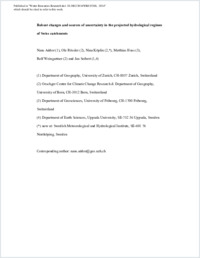Robust changes and sources of uncertainty in the projected hydrological regimes of Swiss catchments
- Addor, Nans Department of Geography, University of Zurich, Switzerland
- Rössler, Ole Oeschger Centre for Climate Change Research & Department of Geography, University of Bern, Switzerland
- Köplin, Nina Oeschger Centre for Climate Change Research & Department of Geography, University of Bern, Switzerland - Swedish Meteorological and Hydrological Institute, Norrköping, Sweden
- Huss, Matthias Department of Geosciences, University of Fribourg, Switzerland
- Weingartner, Rolf Oeschger Centre for Climate Change Research & Department of Geography, University of Bern, Switzerland
- Seibert, Jan Department of Geography, University of Zurich, Switzerland - Department of Earth Sciences, Uppsala University, Sweden
-
01.08.2014
Published in:
- Water Resources Research. - 2014, vol. 50, no. 10, p. 7541-7562
Climate change
Catchment discharge
Uncertainty assessment
Robust projections
European Alps
Impacts mitigation
English
Projections of discharge are key for future water resources management. These projections are subject to uncertainties, which are difficult to handle in the decision process on adaptation strategies. Uncertainties arise from different sources such as the emission scenarios, the climate models and their post-processing, the hydrological models and natural variability. Here we present a detailed and quantitative uncertainty assessment, based on recent climate scenarios for Switzerland (CH2011 data set) and covering catchments representative for mid-latitude alpine areas. This study relies on a particularly wide range of discharge projections resulting from the factorial combination of 3 emission scenarios, 10 to 20 regional climate models, 2 post-processing methods and 3 hydrological models of different complexity. This enabled us to decompose the uncertainty in the ensemble of projections using analyses of variance (ANOVA). We applied the same modeling setup to 6 catchments to assess the influence of catchment characteristics on the projected streamflow and focused on changes in the annual discharge cycle. The uncertainties captured by our setup originate mainly from the climate models and natural climate variability, but the choice of emission scenario plays a large role by the end of the century. The respective contribution of the different sources of uncertainty varied strongly among the catchments. The discharge changes were compared to the estimated natural decadal variability, which revealed that a climate change signal emerges even under the lowest emission scenario (RCP2.6) by the end of the century. Limiting emissions to RCP2.6 levels would nevertheless reduce the largest regime changes at the end of the 21st century by approximately a factor of two, in comparison to impacts projected for the high emission scenario SRES A2. We finally show that robust regime changes emerge despite the projection uncertainty. These changes are significant and are consistent across a wide range of scenarios and catchments. We propose their identification as a way to aid decision-making under uncertainty.
- Faculty
- Faculté des sciences et de médecine
- Department
- Département de Géosciences
- Language
-
- English
- Classification
- Hydrology
- License
- License undefined
- Identifiers
-
- RERO DOC 211427
- DOI 10.1002/2014WR015549
- Persistent URL
- https://folia.unifr.ch/unifr/documents/303733
Statistics
Document views: 133
File downloads:
- hus_rcs.pdf: 215
